The Gift of South Dakota
Subscriptions to South Dakota Magazine make great gifts!
Subscribe today — 1 year (6 issues) is just $29!
The Cattleman's Blizzard
Editor’s Note: On Oct. 4-5, 2013, western South Dakota was pummeled by one of the worst blizzards in the state’s history. Winter Storm Atlas was unexpected and deadly. It began as rain, but then temperatures plummeted and winds began to howl. When the clouds cleared 2 to 4 feet of snow blanketed the Black Hills and surrounding prairie. Ranchers lost cattle, horses and sheep in the tens of thousands. We toured the storm-ravaged West River Country just weeks after the blizzard. Here are stories from the men and women we found struggling to recover.
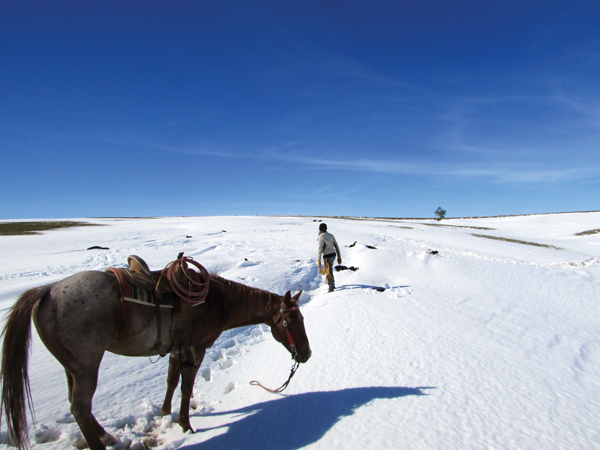 |
| Molly Reinhold looks for survivors in the snow, following the heart-wrenching blizzard that befell West River. Photo by Rachel Reinhold |
LARRY REINHOLD watched the darkening clouds while hurrying to plant a field of wheat on Thursday, Oct. 3. He could almost taste the rain. Quickly jumping off the tractor to check the planter, he nearly landed on a big prairie rattler, but the snake didn’t seem to care. Maybe it sensed that bigger trouble was looming.
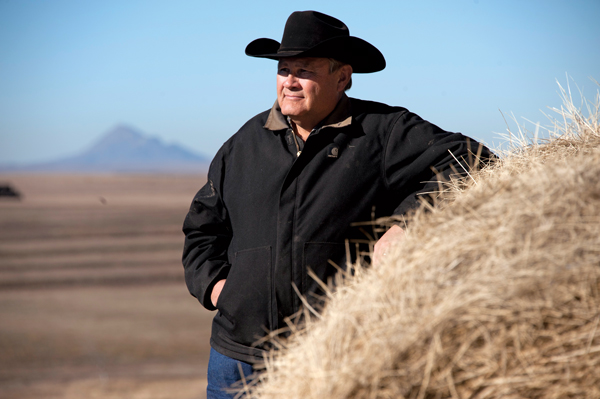 |
| Larry Reinhold called his family together for a prayer as they began the task of recovering from the blizzard. |
Reinhold and his family ranch 20 miles north of Rapid City. Before sunset that Thursday, they brought their cows and calves to a windbreak below a big dam near their house and barns. Many of their mares and colts were sheltered behind a barn in another windbreak. The Reinholds raise and sell quarterhorses, and they also saddle them every summer for 400 youngsters who attend Rainbow Bible Ranch, a camp started by Larry’s parents in 1979.
Further north in Meade County, Dallas Basel was hauling hay from the fields to the yard on that fateful Thursday. He and his wife, Tammy, watched weather reports on television when he came indoors for supper. Rain was forecast, so they locked the sheep in the corral. The Basels’ cattle were about two miles away, still on summer pasture. After years of drought, rains had fallen in 2013 and the grass was still green; cows and calves were getting fat.
On that Thursday afternoon, the Cammacks were moving cattle. “They’d predicted 4 to 6 inches of snow, which you can handle. Most folks had cows 20 or 30 miles away from their home place and that wouldn’t be unusual at all in early October,” said Gary Cammack.
Like most West River ranchers, the Cammacks have many irons in their proverbial fires. Gary and his wife, Amy, bought the Stoneville General Store in 1973. Sales were just $10,000 a year but they hoped it would supplement Gary’s construction jobs. He worked on the local missile sites, the Rapid City Civic Center and een the Alaska Pipeline.
Six years later, business had multiplied 10 times, so they moved from Stoneville — a veritable ghost town, even then — to Union Center, which was only slightly bigger but happened to be on Highway 34, a main West River corridor.
Through the years, the Cammacks added a restaurant, post office, branch bank and beauty shop. But the anchor of Union Center remains the original store, now known as Cammack Ranch Supply, a destination for men and women who spend their days with horses and livestock. The store doubles as a museum; hanging on the walls are harnesses from the Fort Meade cavalary, the headmount of a steer that starred in a Marlboro commercial and fossils unearthed in the neighborhood.
Two of the Cammacks’ sons, Reed and Chris, also run businesses in the town. Reed builds wood cabinets and Chris is a world-class taxidermist.
Union Center, population 50, has a community gymnasium with basketball courts shared by six rural schools, a new fire hall and a Baptist Church landscaped with massive boulders brought from the Black Hills, 30 miles to the west. By Friday morning, Oct. 4, the churchyard looked like a Christmas card as big, wet flakes of snow began to fall.
~
LARRY REINHOLD’S wife, Robin, is a weather observer for the National Weather Service. Her moniker is Hereford 12 SW. She noticed on Friday morning that her measurements were far exceeding the local forecasts. Snow was falling at the rate of an inch an hour. At 2 p.m. on Friday, the lights flickered out in her family’s old ranch house, which was built by Larry’s grandparents in 1929. Power lines across the region were already heavy with snow, and being whipped by winds gusting to 70 miles per hour.
Tammy Basel was worried about the sheep. “Being a nervous person, I kept walking around outside on Friday. At one point it was snowing, lightning and thundering. Dallas was worried that I’d get hit by lightning.” The Basels moved a tractor out of a barn, where it was sheltered, to make room for the ewes and their lambs.
The Cammacks made their way through snowdrifts to the store, but the electricity was dead and nobody was moving on Highway 34. Chris Cammack and a friend, Ben Meyer, decided to try to drive a four-wheel tractor six miles to nearby Enning so they could mount a snow bucket on it and be ready when the storm stopped.
Cautiously, they made their way along Highway 34, both watching for a sign of the road ditch in the white-out of the storm. They arrived and were able to get the bucket mounted. But visibility was next to zero when they started back. Fortunately, they’d tracked their route by GPS so they were able to follow the same path back to Union Center without seeing the road. Driving the tractor was like piloting a plane in dense clouds and fog.
~
DALLAS AND TAMMY BASEL awoke Saturday to a 6-foot bank of snow at their ranchhouse door. But they climbed over it and walked 100 yards to the sheep corral, where they discovered that the storm was a killer.
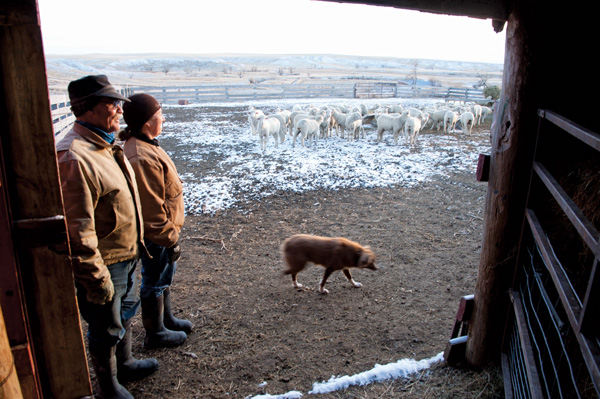 |
| "We don't know any better than to ranch," said Tammy Basel, pictured with her husband Dallas and their sheep herd after the storm. She meant that ranching is a life, not a job. Their ewes' thick wool was washed snow white from the three-day storm. |
Thirteen sheep were lying frozen in a snowbank in the corral. “It was still blizzarding hard,” Tammy remembers. Later that morning, she saw a lone cow come into the yard. If she was theirs, it had traveled 2 miles in the storm. That couldn’t be good, but the weather was too wild to begin a search.
Meanwhile, more than 100 cows showed up in little Union Center. The Cammacks had no idea where they’d come from or who they belonged to, but they herded them into a cattleyard and fed them hay. The highway remained empty of cars and trucks; the world was white and cold.
Larry and Robin Reinhold looked out their windows Saturday morning and saw a scene that looked as if a tornado had blown through. Trees were stripped of branches from the wind and heavy snow. Huge snowdrifts stretched between the house and barn.
Finally, on Saturday afternoon, the wind and snow began to subside so the Reinholds made their way through the drifts; soon they had their first inkling of the devastation. Four horses lay dead in the shelter of the corral.
The two oldest Reinhold children — Rachel, 19, and Molly, 17 — began to search beyond the yard and saw an unusual sight — a line of mule deer mixed with antelope, walking single file, making their way through the deep snow.
The dam seemed like a surly ocean. It was filled to the brim from the precipitation, and waves were beating against the eastern bank. The family’s wily Hereford herd bulls had come into the yard. One stood on the porch of a little cabin.
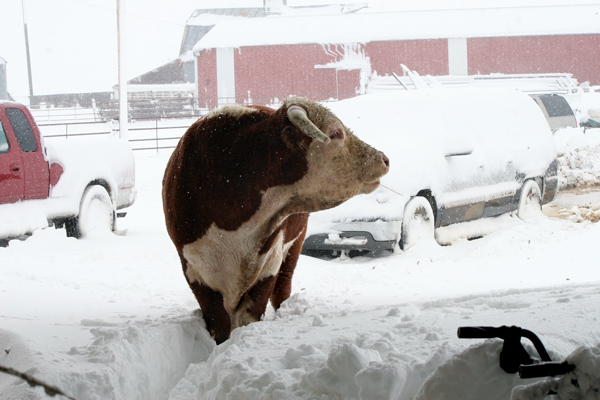 |
| A Hereford bull took shelter on the porch of a cabin in the Reinholds' yard. |
Darkness came before they or hundreds of other ranch families could assess the situation. They went to bed hoping that the cows and horses that were miles away might have survived, but most had seen enough to fear the worst.
Most ranchers couldn’t tune into the evening news that dismal night because their power was off, so they didn’t hear that the National Weather Service had named the storm Atlas. In Rapid City, NWS was staffed by dedicated meteorologists who’d walked through drifts to get to their stations, even though they were on unpaid leave due to a government shutdown in Washington, D.C.
~
SMALL CHURCHES are scattered across the West River countryside. Tiny Milesville is down to just one residence, and the post office closed last year, but it still has two churches.
Roads were impassable so the pews were empty Sunday morning, Oct. 6. Ranchers climbed into the cabs of their biggest tractors and started trails through the deep snows so they could search for their stock. As the sun rose, the snow took on a blue glow because it was so heavy with preciptation. County and state highway workers began to clear the roads, and they were sickened by the number of dead cattle they were finding.
Electricity was still off, but REA linemen were immediately in the country, replacing poles and reconnecting broken wires.
The Basels and their neighbors rounded up 700 cows and began the task of sorting them by brands. Their tiny grandson was just beginning to string words together; his first phrase was “dead cow there.”
Cammack is a state legislator, one of three who represent District 29, a big swath of West River that was in the heart of the storm. His fellow district lawmakers, Dean Wink and Larry Rhoden, also ranch near the center of the storm. All three had cattle to find, but they spent time on the phones, consulting with state and county authorities about the recovery.
Words are seldom the measure of a man in rural South Dakota, especially not the quantity spoken. In hard times, a South Dakotan is likely to speak even less than normal so the three rancher/lawmakers filled a vacuum, and became spokesmen even though they had their own sorrows to sort through.
The national media was calling. The blogosphere erupted both with sympathy and stupidity. “Why didn’t they get the cattle indoors,” asked one urbanite. Comments like that were read and heard by the struggling ranchers who already were dealing with myriad emotions.
“It’s one of those things when if you come over the hill and you see dead cows dotted over the prairie, your first thought is it’s your responsibility to take care of those livestock,” said Cammack. “I don’t think there’s one person whose first thought was about their equity. Their first thought was that they’d failed their stewardship responsibility to those animals.”
Cammack told the New York Times and other reporters that ranchers mustn’t blame themselves. “That’s easy to say and hard to do,” he added. “There is not a producer who didn’t question himself 20 times a day.”
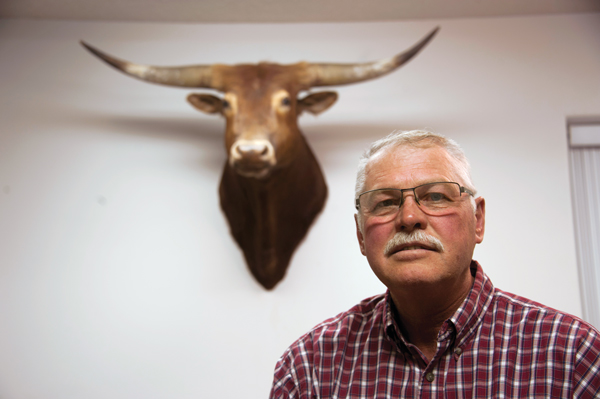 |
| In the days following the storm, Gary Cammack had his own ranching disaster to deal with, but he also had responsibilities as a state legislator. |
Cammack said one of the best livestock lessons he ever heard came years ago from Robert Funnel, a neighbor and the father of Tammy Basel. “I’d lost a couple head of cattle and Robert told me that one of the things that kept him in business was ‘you got to step over the dead ones and take care of the live ones.’”
At the Reinhold ranch, the parents and six children tried to keep a perspective. At one point, they stopped the search to reflect on what had happened. “We prayed that while the horses’ and cows’ paths had ended, ours must continue on,” Larry said.
And then they continued to look for survivors. They found live cows, buried to the neck in wet, cold snow, and they dug them out by hand and shovel. Twenty-five horses were nowhere to be found. “In our heads we knew they were probably gone,” said Rachel. But you search with your heart.
Finally, on Wednesday morning she and Molly found the last bunch. They were strung out in a long line on the prairie, a few hundred yards apart, for several miles.
It’s one thing to lose cows with numbered ear tags, said their father, but it can’t compare with losing horses named Cocoa, Sweetheart, Marigold, Okey and Rosie.
“They were like our best friends,” said Rachel, Rainbow Ranch’s head wrangler. “We lost 21 really good saddle horses.” One of them was Champion, a 6-year-old given to her brother Caleb for his birthday.
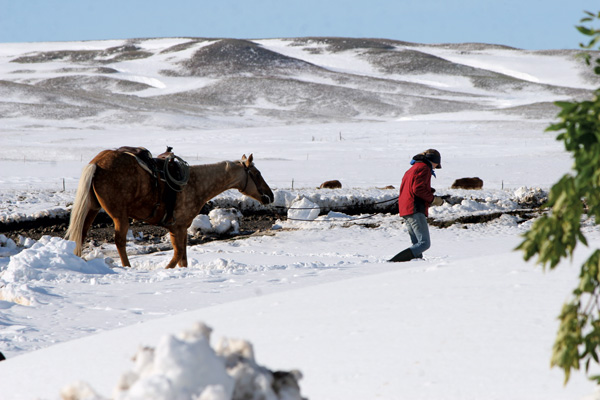 |
| Rachel, the eldest of the Reinhold children, led her horse Pocokota through deep drifts as she looked for missing cows and horses. The four-day search ended with a heart-breaking discovery. |
The final count was 91 horses dead, and 140 still alive. But the living horses also suffered. “They looked dazed, just like us, walking around kind of staring even weeks later,” said Larry. “Some of their bunch aren’t there. They had their buddies and they’re gone.”
One month after the storm, State Veterinarian Dustin Oedekoven reported that 13,977 cattle had been confirmed dead, along with 1,257 sheep, 287 horses and 40 bison. Some cattlemen think the losses might be twice that number, but it’s likely that a lot of ranchers won’t report their numbers unless the federal government approves a disaster relief program.
Oedekoven also said that while some of the livestock drowned in swollen creeks and dams or were simply buried in snow, many died from hypothermia. The cold rain and biting wind, followed by a two-day blizzard was three strikes.
Hypothermia eventually stresses the cardiovascular system to the breaking point. Before that happens, however, it can cause a creature — man and beast — to become confused and disoriented. That may explain why cattle and horses left shelter and drifted for miles before collapsing, usually in stride with their hind legs stretched out behind them, still pushing onward.
~
THE AFTERMATH OF the Cattleman’s Blizzard won’t be written for a long time. The impacts, both financially and psychologically, are impossible to predict.
Most of the ranchers who suffered losses are third or fourth generation stockmen, and while they’ve never experienced a deadly blizzard like 2013, they have perservered through decade-long droughts, depressed prices, diseases, floods and grass fires. “Quit” is a four-letter word they don’t know.
“We don’t know any better than to ranch,” said Tammy Basel, over coffee at her kitchen table six weeks after the blizzard. “I say that in the most sincere and joking way. Most of us would hardly know what to do with ourselves if we had a 40-hour, $40,000 a year job in town.”
A number of ranchers lost two-thirds of their cows, and for some that was the bulk of their net equity because many lease land from the government, from relatives or from strangers who’ve invested in cowboy country, sometimes for the hunting rights.
Everybody feels badly for the youngest ranchers who were just beginning to build a cow herd in an era of record-high prices for cows. But most ranchers can also point to a neighbor nearing retirement who doesn’t have much land and probably lacks the time or energy to start over.
“The effects will be felt 10 years from now and we will lose families,” said Cammack, the state legislator. “The biggest hope is with all the folks in Washington that represent us.” In the blizzard of 1996-97, when losses were far less, cattle and sheep producers received payments that covered about 65 percent of their losses.
“There’s only so much a bank can do with today’s regulations,” he said. “From a state perspective, there are some things we need to consider, maybe some loan guarantees or interest buydowns. If we can only help six or 10 families that’s still something.” Six or 10 families in Meade County covers a lot of territory.
The most immediate aid sprang from a Rancher’s Relief Fund organized by farm groups and the Black Hills Community Foundation. Donations neared $1 million by Thanksgiving week, and even though losses are probably 20 or 30 times that amount the generosity of strangers buoyed the spirits of the cattlemen. (The Rancher's Relief Fund closed on May 31, 2014, having accumulated $5.4 million in donations).
Daily life was also returning to some sense of normalcy. Union Center’s basketball gymnasium reverberated in late afternoons with ball dribbling. Livestock auction barns at Faith and Philip were selling the spring calves that survived the storm, usually for more than $2 a pound — a thousand dollars a head.
The churches were open again on Sundays, and for weddings and funerals. When life turns abnormal, the normalcies are safe refuges.
Larry Reinhold, who had Bible School training before he returned to the family ranch, is a regular speaker at churches and religious gatherings. He once conducted a burial at the Piedmont Cemetery for an old neighbor who had a limestone quarry. Quoting Laura Ingalls Wilder, he reflected that the prairie has already claimed our blood so it might as well take our bones.
Reinhold recalled that particular eulogy as he talked about the October storm. Wilder was an East River farmer’s daughter, but she must have also endured some losses to so aptly describe the sentiments of the survivors of the Cattleman’s Blizzard.
Editor’s Note: This story is revised from the January/February 2014 issue of South Dakota Magazine. To order a copy or to subscribe, call (800) 456-5117.


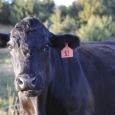
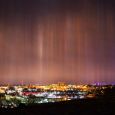
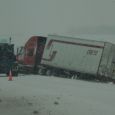

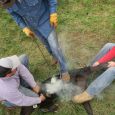
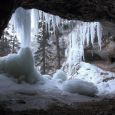


Comments
Epitaph for Atlas
By Mark Peacock
The clouds are getting dark now, mom, and the rain is coming down.
There’s lightning and there’s thunder now, and snow falls all around.
The air is getting cold now, mom…and my coats’ not set for snow.
The wind and sleet, they hurt my skin…where will we cattle go?
We huddle all together, mom, to keep the cold away
but now the painful, stinging snow has pushed us in harm’s way.
First through one fence and now through two, I’m pinned against the wire.
The barbs are ripping at my skin; the snow is getting higher.
My hooves are buried in this mud that’s cold and dark and deep.
The other cows are crushing me, and you’re falling asleep.
The storm is getting worse now, mom, the weight’s pulling me down
with fifty others just like us now frozen to the ground.
Why leave me when I need you most? My tears freeze as I weep.
You told me we’d get through this storm…a promise you can’t keep.
I don’t know if there’s heaven, or where we cows will go
but if there is I pray to God to save us from this snow.
A week ago in better times, we grazed this prairie lawn
but now I’ll close my eyes and join one hundred thousand gone.